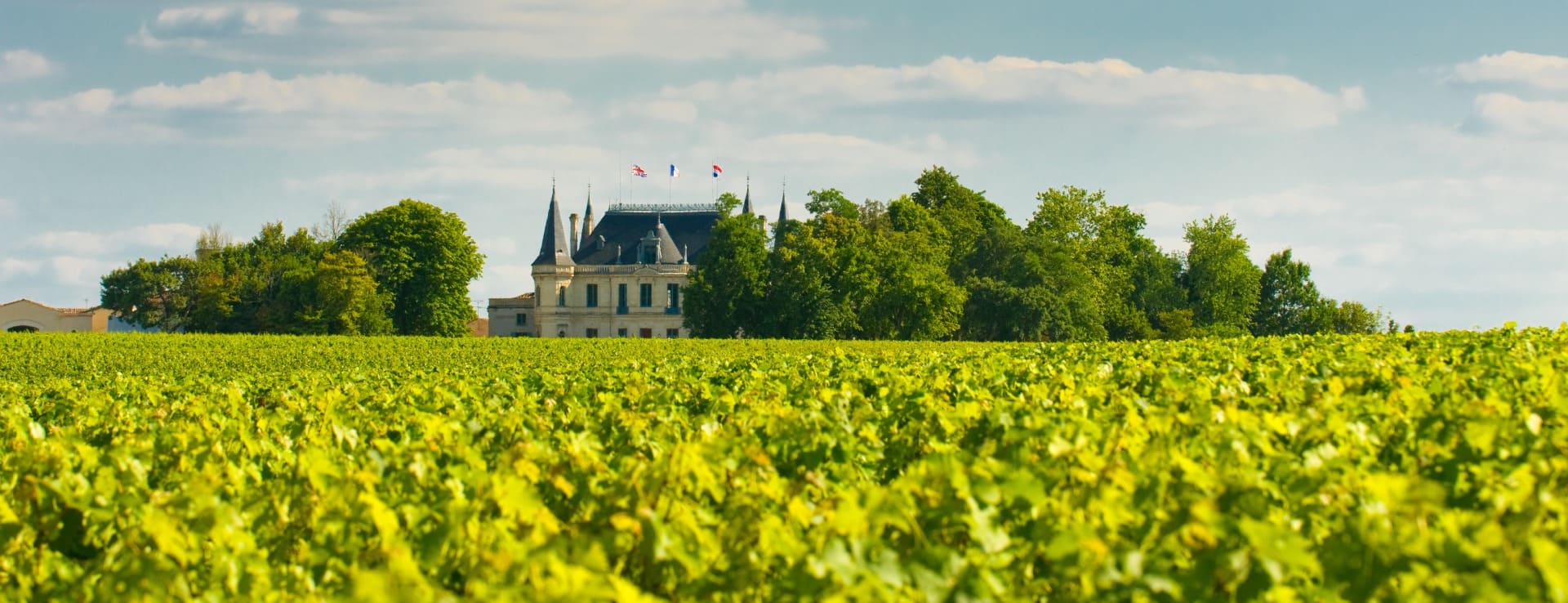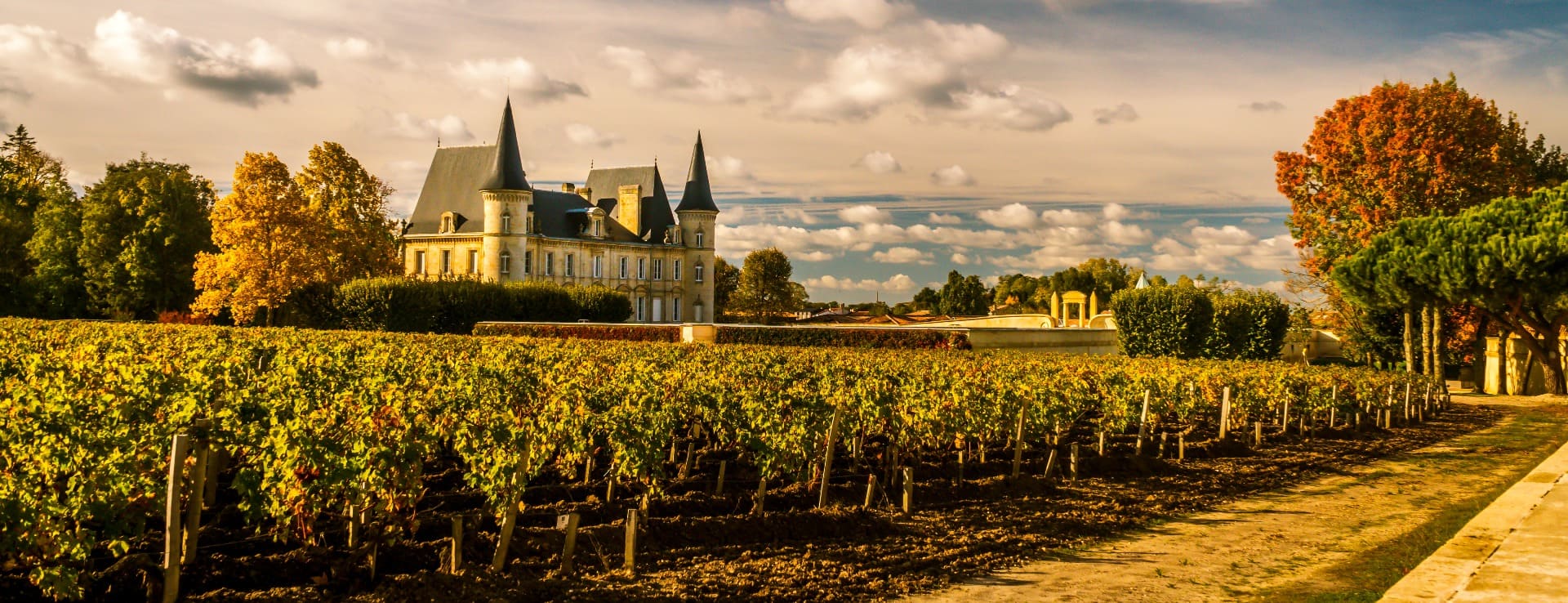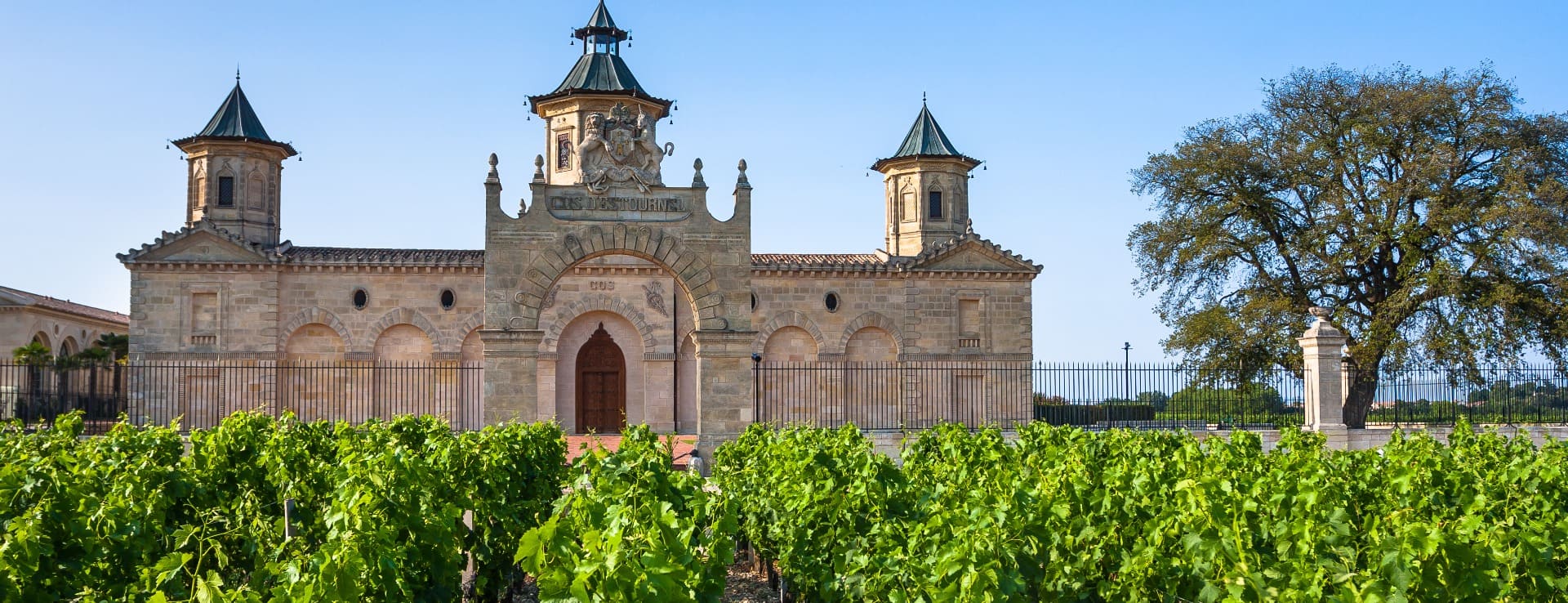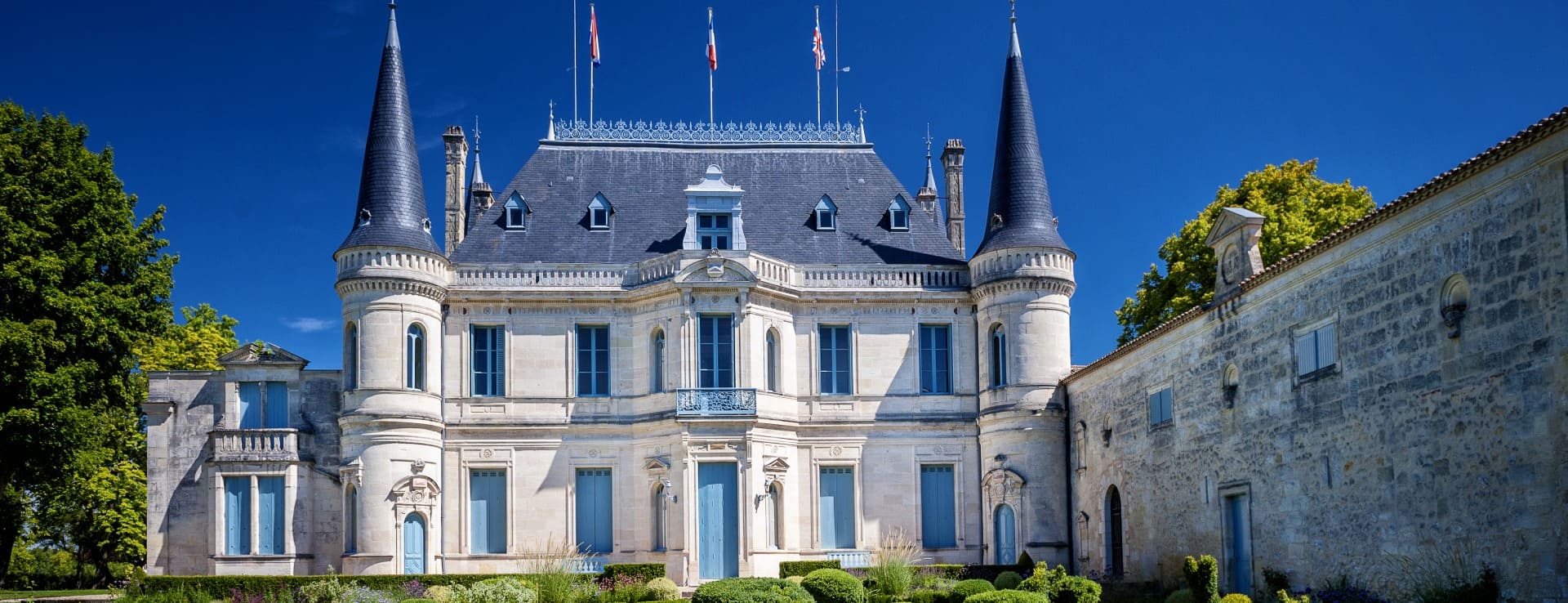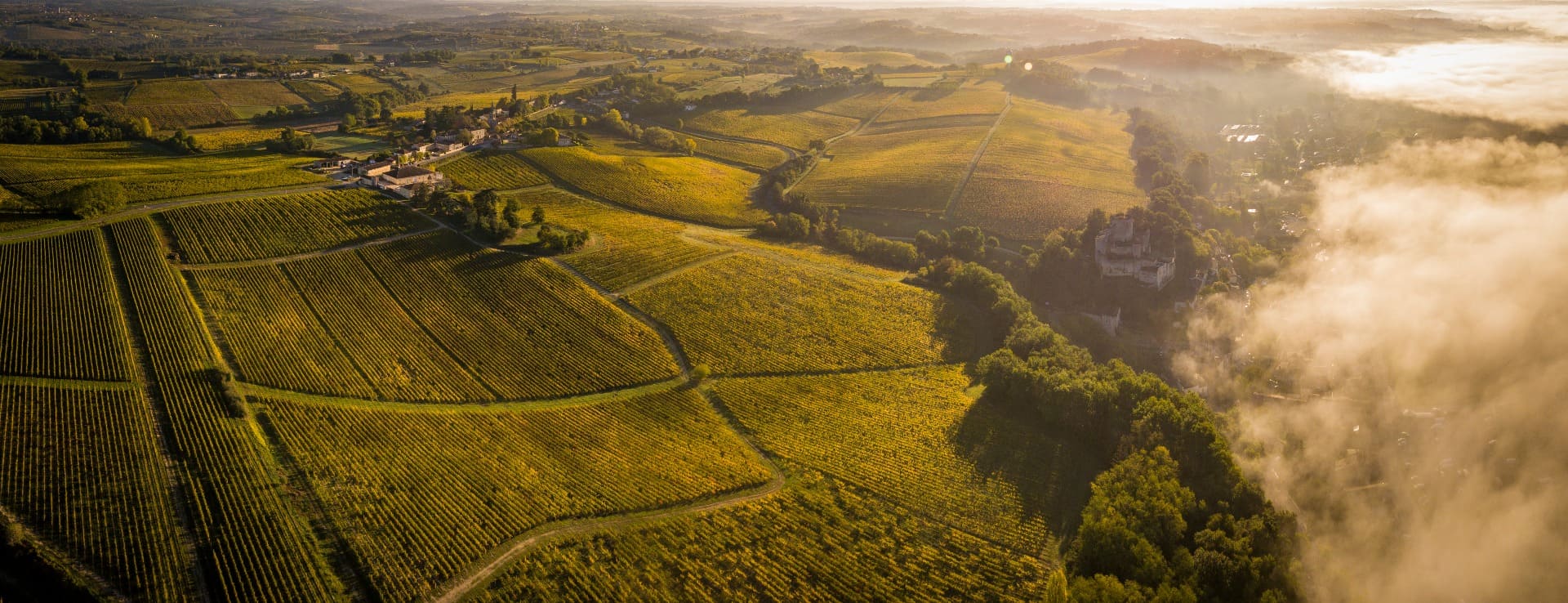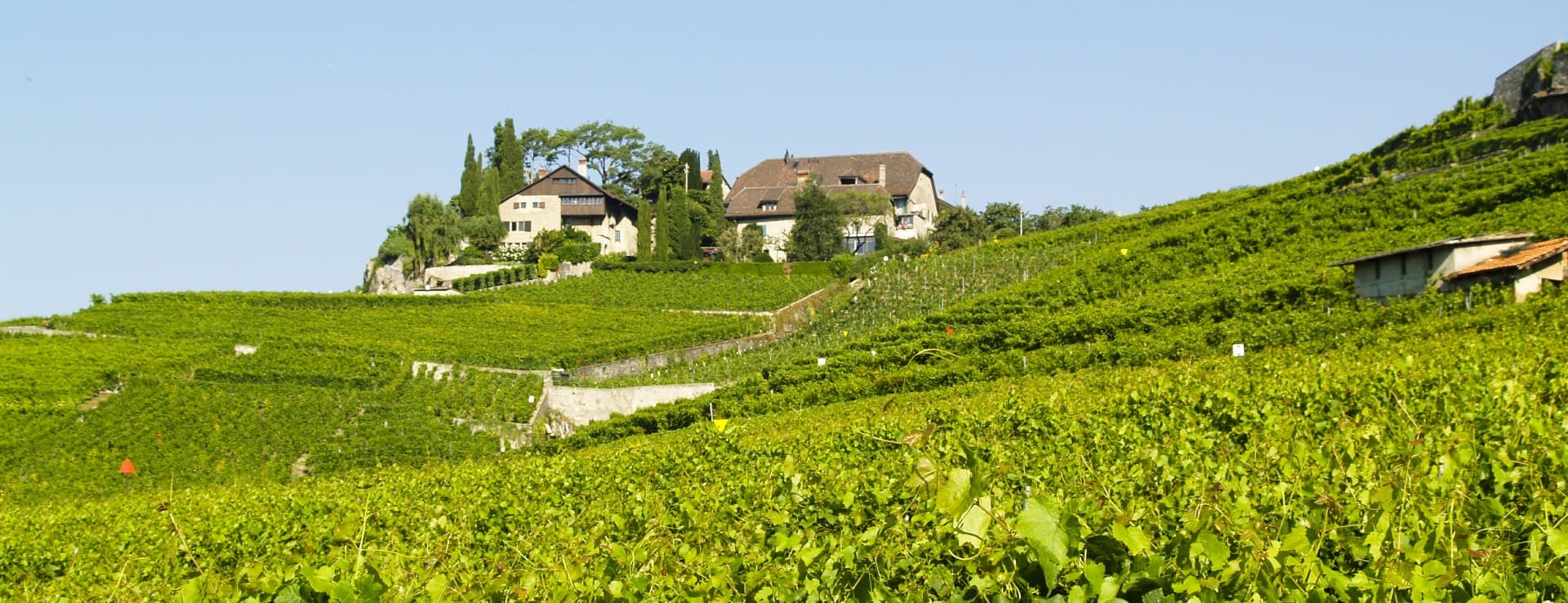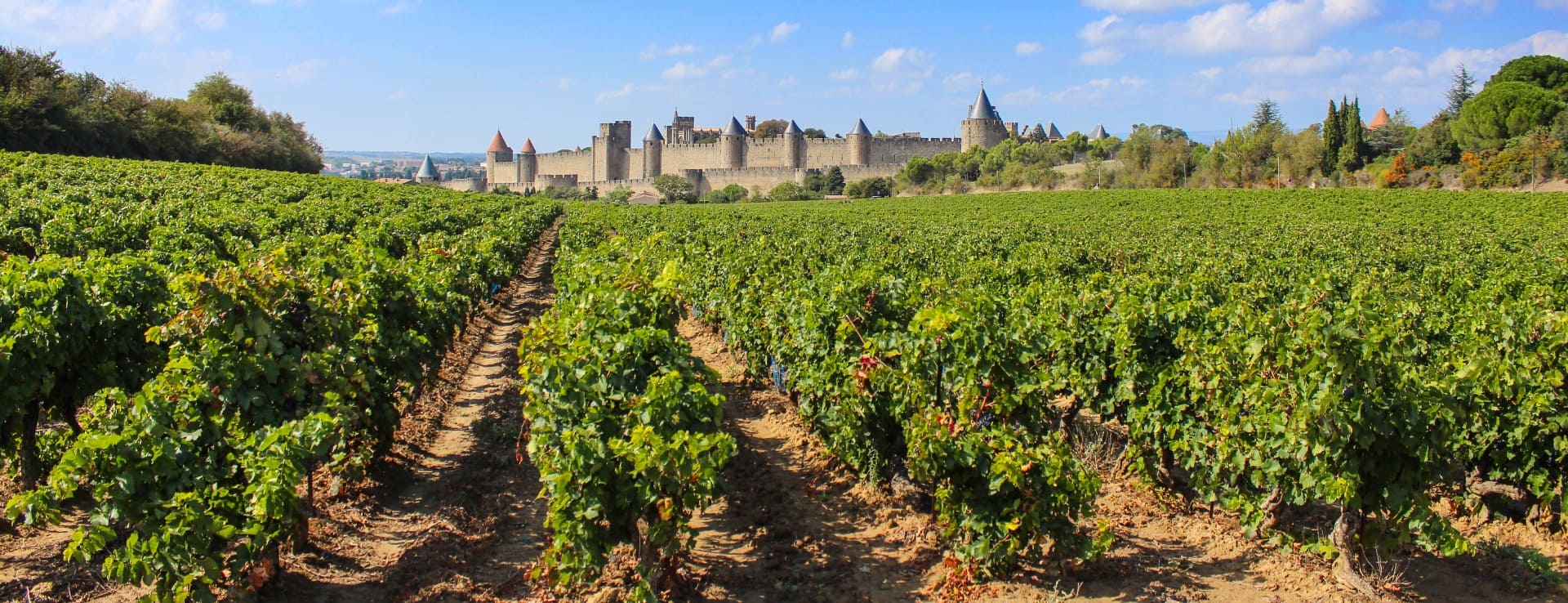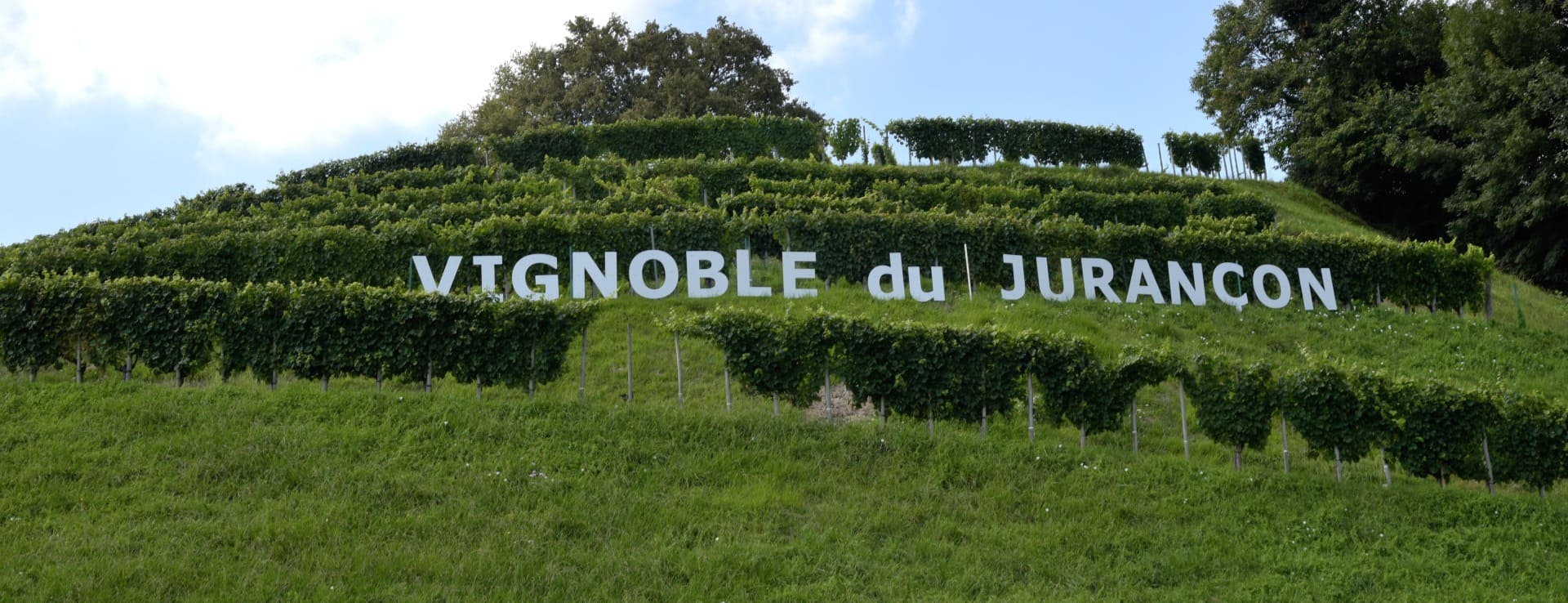Find your winery or vineyard
Infographic of the Denomination of Origin
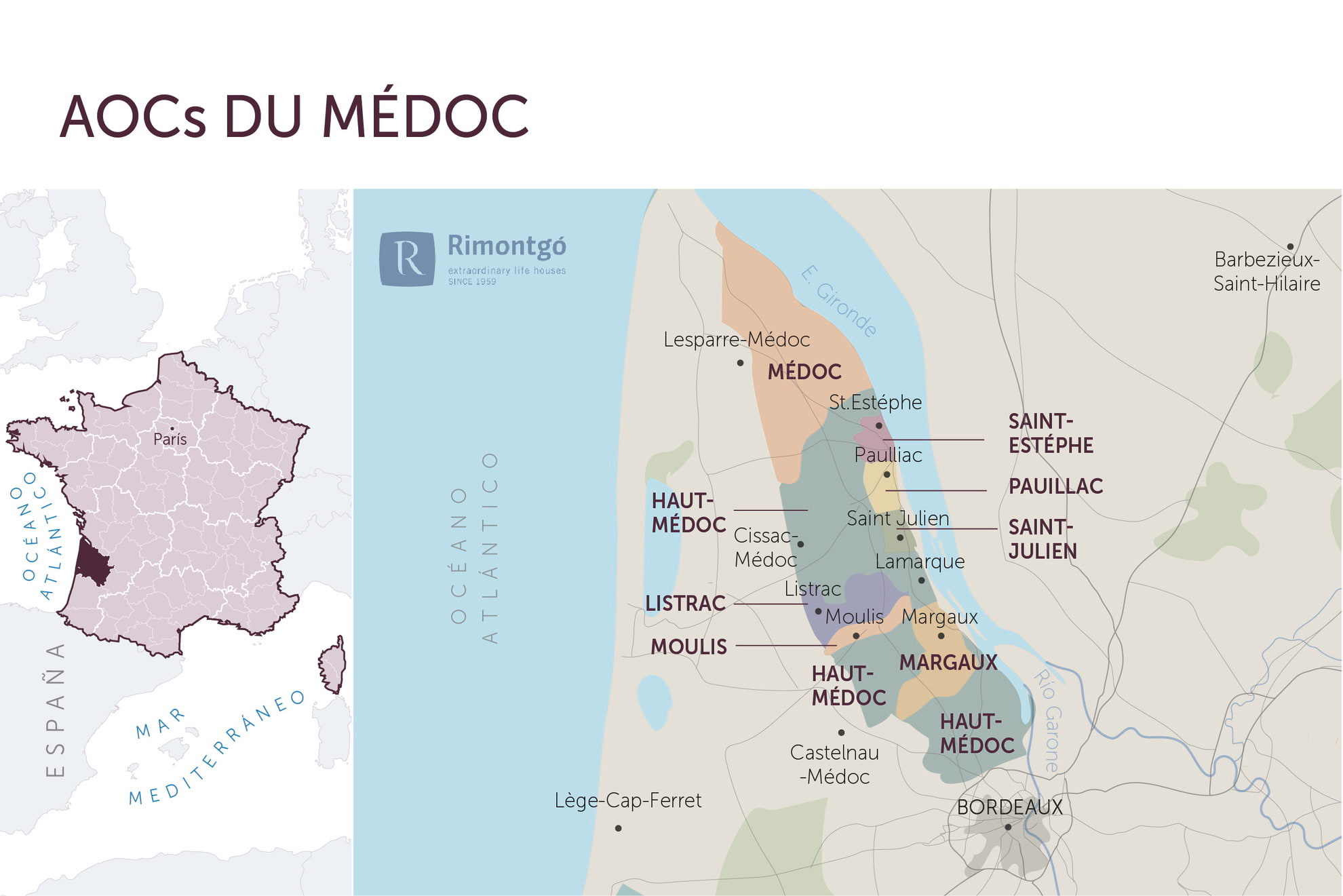
Change to imperial units (ft2, ac, °F)Change to international units (m2, h, °C)
AOC Margaux / AOC Pauillac / AOC Saint-Julien
The great wines of the Médoc see life in red. From a ruby colour like the Haut-Médoc wines to the deep black of the great young Pauillacs, the colour palette evolves in a long register.
The great variety of terroirs and AOCs in the Médoc is expressed in a great diversity of wines, which are made with a dominant grape variety, the cabernet sauvignon grape, which has the particularity of offering violet reflections that fade with age, the variety ages very well and the wine is very lively with intense sparkles at 30 years of age. Generally, the wines of the AOC Haut-Médoc, Médoc, Moulis et Listrac have a ruby colour layer that will evolve into a russet colour over the years. The Margaux and Saint-Julien wines have a denser robe, the Pauillac wines also have a dark tone and the Saint-Estèphe wines are full-bodied and opaque. On the nose the Médoc shows notes of cassis, spices, tobacco cedar, mocha, cocoa, liquorice and others... The cabernet sauvignon grape grown in these hot lands grows very well, the soils are composed of small stones and sand with a little clay and they are the ones that help to show the aromatic complexity of cabernet sauvignon. Smooth like a full-bodied and generous Margaux like a Saint-Estèphe, deep like a Pauillac... Margaux wines are identifiable thanks to their great softness and a certain form of femininity. Whereas the Pauillac wines have contrasting styles, comparable to the first three crus classés, sweet and seductive like Mouton Rothschild or Lynch-Bages, powerful like Château Latour and Pichon Longeville, more reserved like Lafite Rothschild or Duhart-Milon. The Saint-Julien wines are halfway between Pauillac and Margaux, while the Saint-Estèphe wines show their corpulence through a certain opulence and are rather closed on the palate.
THE VINEYARD
The vineyard of the "middle country" or "country between two waters" because it is surrounded by two large areas of water on both sides, the Médoc is almost an island which was the last territory of the Gironde where the culture of the vineyard appeared. In a few centuries this area has become the most prestigious vineyard in the world, where the châteaux stand like cathedrals dedicated to wine.
These two bodies of water are the Atlantic Ocean and the Gironde estuary. The vineyard landscape is flat with rolling hills full of vineyards. The surface area of each Château is very important here, more so than in other areas. Also the presence in the landscape of the beautiful châteaux of sometimes grandiloquent style accentuates the opulence of the region. They seem to have always stood there unchanged and take us back in history. This area of the Médoc has always been an area of pioneers, sparsely inhabited in the Middle Ages, it was populated and cultivated by generations of men coming from all over Europe and from other regions of France, a bit like the Far West. Dozens of villages, poor people and great fortunes have succeeded each other on these lands in order to shape the vineyards we know today. Built on virgin land, the châteaux have grown rapidly, far from the feudal model on which other Bordeaux vineyards have developed. A dynamism that has given the Médoc its modernity since the 17th and 18th centuries, to become the most prosperous vineyard in Bordeaux. The best testimony is undoubtedly the 1855 classification which theoretically covered all the wines of the Gironde. Today, the 60 classified Médoc châteaux represent some 3,000 ha of vineyards, 20% of the Médoc's surface area.
In the Médoc, the planting density is 10,000 feet per hectare in many plots.
THE AOCS
The Médoc is made up of 8 AOCs, 6 communal and 2 sub-regional, on these ridge lands where only red wine is produced, mainly from the Cabernet Sauvignon variety.
Although this vineyard appears to be quite extensive, it actually covers only 16,500 ha, i.e. 14% of the Bordeaux vineyard. It extends over a narrow strip along the left bank of the Gironde estuary, giving way to the forest and the coastline further west. From Blanquefort in the south to Saint-Vivien de Médoc, at the northern tip of the Semi-Seine, there are eight AOCs, divided into two families: two sub-regional AOCs which together cover the whole of the Médoc vineyard and six communal AOCs, limited to specific villages. Some châteaux produce a small quantity of white wine, such as Château Margaux (Pavillon Blanc) or Château Talbot (Cailou Blanc) but these wines are only eligible for the Bordeaux regional AOC.
AOC Haut-Médoc: covers 4,708 ha of vineyards. The name of the AOC is due to its geographical location upstream. It starts in Blanquefort in the south and ends in Saint-Seurin-de-Cadourne in the north, covering the southern part of the Médoc, including the 6 AOCs of the villages of Margaux, Moulis, Listrac, Saint-Julien, Pauillac and Saint-Estèphe. It can serve as a back-up AOC when the wines are not good enough for the AOCs of each village.
AOC Médoc: covers 5,750 ha of vineyards. If we look at the texts of the AOC, it covers the entire Médoc vineyard. But in reality the crus claiming the AOC Médoc are located downstream of the AOC Haut-Médoc, the downstream part of the vineyard from Saint-Ysans-de-Médoc to Saint-Viviende-Médoc.
AOC Margaux: covering 1,493 ha, this vineyard is the largest of the 6 communal AOCs and extends over 5 villages (Margaux, Cantenac, Soussans, Arsac, Labarde). It is also the AOC with the largest number of Crus Classés, a total of 21, including 1 Grand Cru Classé, Château Margaux. This AOC is characterised by a gravelly terroir that gives the wine an incomparable finesse.
AOC Moulis: covers 630 ha of vineyards. This small AOC owes its name to the number of mills that were once present in the area. It has no Cru Classé, but its reputation has been built on the quality and homogeneity of the 40 crus of Moulis, among which Château Poujeaux, Chasse-Spleen and Maucaillou are the most illustrious representatives. The fact of its remoteness from the river makes the AOC more sensitive to climate variations, for example frost, and if the weather conditions are difficult, these châteaux will be less efficient.
AOC Listrac-Médoc: covering 623 ha of vineyards, it is the smallest AOC in the Médoc and like its neighbouring AOC (Moulis) does not have any Cru Classé. The two AOCs share their sensitivity to climatic changes. However, there are still good properties, the formerly called classés crus bourgeois such as Château Clarke, Fourcas-Dupré, Fourcas-Hostens or Fonréaud. These properties express beautifully the fruity yet fleshy side of Listrac wines.
AOC Saint-Julien: covers 909 ha of vineyards. Although the AOC does not have a Premier Cru Classé, Saint-Julien nevertheless groups together 11 crus classés which alone represent more than 80% of the AOC. This qualitative concentration is one of the successes of these wines. Château Léoville las Cases is the most sought after of all together with its companions Ducru-Beaucaillou and Léoville-Barton.
AOC Pauillac: covers 1.204 ha of vineyards. Only in this AOC there are 3 Premiers Crus Classés out of 5, Château Latour, Château Lafite Rothschild and Château Mouton Rothschild. This characteristic says a lot about the quality of the AOC because as in its neighbour Saint-Julien, the total of crus classés represents 80% of the vineyard of the whole AOC. Some of the best-known wines in Bordeaux are produced here and their inimitable class, aromatic complexity and finesse place them at the top of regional production.
AOC Saint-Estèphe: covers 1,226 ha of vineyards. It is the most northerly of the communal AOCs and above all known for the typicity of its wines: spaced, full-bodied and endowed, the best wines of the AOC, with great finesse. It is also the AOC with the most rugged geography, with terroirs of many contrats. Vineyards such as Montrose, bordering the river or Cos d'Estournel, the other Second Cru Classé, perched on top of one of the highest hills in Médoc. This Château Cos D'Estournel is considered a super second that sometimes rivals the Premiers Crus Classés and is the one that has carried the banner of the AOC.
THE SOILS
The terrain of the Médoc is sculpted by the water of the Garonne and its tributaries, creating cotarres on the successive hills, perpendicular to the Gironde, on which the communal AOCs are planted. The Médoc is not only surrounded by water, but water has given it its current landscape. A geological work that has been carried out over millions of years, but which makes the Médoc a fairly recent geological construction. At the end of the Quaternary, a climatic warming caused the ice to melt, releasing large bodies of water. These waters carried with them a quantity of sediments. Sands, gravels, clays, stones and pebbles spread as a layer on the surfaces and form what we call gravels. For about 2 million years, these famous sedimentary layers of gravel are deposited on top of the Tertiary limestone bedrock, remnants of the tropical seas of the past. The layers are divided into four types conceived in different epochs and are distinguished by their decreasing altitude. The oldest are the Pyrenean gravels of the high terraces, which mainly form the western part of the Médoc vineyard, AOC Moulis. Then, during the last million years of the Quaternary, they join the gravels of the Garonne, which are larger and very visible in the AOC Margaux. They are composed of quartz, sandstone, silex, volcanic lithium, flint, sand and clay. They are spread throughout the AOCs of the Médoc. Then there are the two extensions of Mindel gravels which make up the intermediate terraces, the most important ones, generally located on the banks of the Garonne and finally some gravels from the Riss period which are distributed along the excavation of the current river.
In each period, nature shapes the terroirs of the Médoc by attributing to them a different geological history. Erosioned by the waters, pushed by the rise of the Charentes plain, the terraces become gravel beds on the tops of the hills perpendicular to the river, an ideal form for draining the soil and favouring the cultivation of vines. Thus, when we look at the succession of gravel ridges along the Gironde river, we can see that all the AOCs are built around these gravel terraces on the tops of the hills, separated from each other by the streams, where the corn and poplar plantations still exist in certain places.
THE HISTORY OF WINE
From the 16th to the 17th century was the arrival of quality in the world of wine. With the arrival of the Dutch from the 16th century onwards, the vineyards gradually recovered and gradually moved towards quality production, which was to set the first stamp on the future of the Girondin vineyards. After the defeat of the English army at Castillon in 1453, which marked the return of Aquitaine to the kingdom of France, the vineyard lost its main market, which was England. A disastrous situation for viticulture, the marketing of the wines is divided by 10 in a few months. It was the end of a golden age or the beginning of a dark period that would last more than 50 years. But it was at the beginning of the 16th century, with the arrival of the Dutch fleet, a key element of the new power of the United Provinces, that the Bordeaux vineyard gradually regained its colour. While the English were interested in clarets, light red wines produced in the region, the Dutch were mainly looking for cheap white wines to distil to produce marc, easy to transport by sea to distant countries and which could be drunk by sailors. This is how Cognac and Armagnac were invented. The action of the Dutch had a decisive influence on the Bordeaux vineyards, with red varieties being replaced by white varieties better adapted to the market. Until the middle of the 20th century, Bordeaux produced mainly white wine. The Dutch were also fond of natural sweet wines, thus ensuring the growth of vineyards in the Sauternes, Loupiac and Bergerac regions.
From the middle of the 17th century, the triangular trade between Africa and France and the colonies of the West Indies began. Bordeaux became one of the main ports for blacks. This trade also encouraged the export of Bordeaux wines to the American continent, opening up new outlets, particularly to northern Europe. In this context, a new generation of merchants from Ireland, Germany, Holland, Russia and Sweden settled in Bordeaux and established the first dynasties of Bordeaux merchants. The 18th century was the belle époque for Bordeaux. It was a golden age which led to a qualitative improvement in the quality of the crus. The wealthy Bordeaux parliamentarians created their wine châteaux. Among the best known were the Ségur, Longueville and Malescot, which were followed by the rich merchants of "la place" (the Bordeaux wine stock exchange). Expansion took place around the city of Bordeaux, but especially in a hitherto little exploited area, the Médoc. This land of pioneers became the laboratory of modern viticulture, freed from the feudal rules that governed older vineyards such as Saint-Emilion or Pomerol. In the Médoc, where the few existing vineyards were only exploited by a few monasteries, the large estates suddenly flourished and in just a few years dominated the market for quality wines.
It was also from 1745 that the first classifications of the best wine châteaux were made, established on the basis of the average selling prices of the crus by the town's wine brokers. In 1765, the prosperity of the Bordeaux vineyards reached its peak. In that year, 128,000 barrels were exported, a record. Within this international trade, the balance of power changed. America became a major export area and England was only a marginal market, accounting for only 4% of the volume of wine exported. Although the wine privileges were abolished by Turgot in 1776, it was the French Revolution of 1789 that shattered this economic prosperity.
CLASSIFICATION
The classification of 1855 was intended to make the best presentation of Médoc wines at the Universal Exhibition in Paris in that year with Napoleon III as Emperor of France. The Bordeaux Chamber of Commerce decided to establish a classification for wine brokers and merchants based on the average price of the wines in the last few vintages. Two classifications were established, one for reds and one for whites. Thus, only the red crus of Médoc, the sweet wines of Sauternes and Château Haut-Brion are mentioned in the classifications because at the time their prices were twice as high as the wines of Graves and three times higher than those of Saint-Emilion and Pomerol. There are 61 red crus classified in five categories. This historical classification has only been modified once in 1973 to promote Château Mouton Rothschild to Premier Cru Classé.
Premiers Crus Classés (5)
Chàteau Lafite Rothschild (Pauillac)
Château Latour (Pauillac)
Château Margaux (Margaux)
Château Mouton-Rothschild (Pauillac)
Château Haut Brion (Pessac-Léognan)
Deuxièmes Crus Classés (14)
Château Brane-Cantenac (margaux)
Château Cos d’Estournel (Saint-Estèphe)
Château Ducru-Beaucaillou (Saint-Julien)
Château Dufort-Viens (Margaux)
Château Gruaud-Larose (Saint-Julien)
Château Lascombes (Margaux)
Château Léoville Las Cases (Saint-Julien)
Château Léoville Poyferré (Saint-Julien)
Château Léovile Barton (Saint-Julien)
Château Montrose (Saint-Estèphe)
Château Pichon-Longueville (Pauillac)
Château Pichon-Longueville Comtesse de Lalande (Pauillac)
Château Rauzan-Gassies (Margaux)
Château Rauzan-Ségla (Margaux)
Troisèmes Crus Classés (14)
Château Boyd-Cantenac (Margaux)
Château Canon-Ségur (Saint-Estèphe)
Château Cantenac-Brown (Margaux)
Château Desmirail (Margaux)
Château Ferrière (Margaux)
Château Giscours (Margaux)
Chàteau d’issan (Margaux)
Château Kirwan (Margaux)
Château Lagrange (Saint-Julien)
Château La Lagune (Haut-Médoc)
Château Langoa-Barton (Saint-Julien)
Château Malescot-Saint-Exupéry (Margaux)
Château Marquis d’Alesme-Becker (Margaux)
Château Palmer (Margaux)
Quatrièmes Crus Classés (10)
Château Beychevelle (Saint-Julien)
Château Branaire-Ducru (Saint-Julien)
Château Duhart-Milon (Pauilllac)
Château Lafon-Rochet (Saint-Estèphe)
Château La Tour Carnet (Haut-Médoc)
Château Marquis de Terme (Margaux)
Château Pouget (Margaux)
Château Prieuré-Lichne (Margaux)
Château Saint-Pièrre (Saint-Julien)
Château Talbot (Sait-Julien)
Cinquièmes Crus Classés (18)
Château d’Armailhac (Pauillac)
Château Batailley (Pauillac)
Château Belgrave (Haut-Médoc)
Château Camensac (Haut-Médoc)
Château Cantemerle (Haut-Médoc)
Château Clerc-Millon (Pauilac)
Château Cos Labory (Saint-Estèphe)
Château Croizet-Bages (Pauillac)
Château Dauzac (Margaux)
Château Du Tertre (Margaux)
Château Grand-Puy-Ducasse (Pauillac)
Château Grand-Puy-Lacoste (Pauillac)
Château Haut-Bages Libéral (Pauillac)
Château Haut-Batailley (Pauillac)
Château Lynch-Bages (Pauillac)
Château Lynch-Moussas (Pauillac)
Château Pedesclaux (Pauillac)
Château Pontet-Canet (Pauillac)
Discover more wineries and vineyards for sale in these wine regions in France
Subscribe to our mailing list to receive news about wineries and vineyards.

